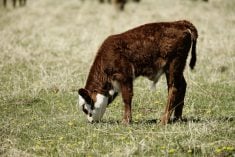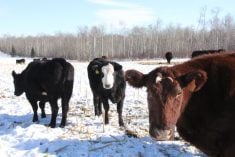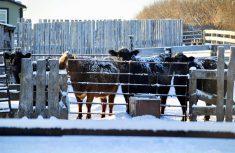Conventional preconditioning programs generally include at minimum — castration, dehorning, vaccination against clostridial and bacterial diseases, parasite control, weaning for a period of 30-plus days, and acclimation to feedstuffs, bunks and water bowls prior to sale. The term itself is not narrowly defined and can mean different things to different people including a combination of calves vaccinated once, twice or even three times, depending on the live or killed vaccines used.
The intent of preconditioning for 30 to 45 days is to spread out the weaning, trucking, vaccination, dam separation, unfamiliar animals and environmental stressors that the calves face, so that the immune system is not overwhelmed. Shrinkage of calves weaned more than 30 days is accepted to be roughly three per cent in comparison to five to six per cent for calves weaned directly to the auction barn. A higher demand can be placed on them due to their feedlot conditioning regarding bunk and feed training plus adaptation to water bowls. Vaccination protocols assume the necessary time for a calf’s immunity to raise their level of resistance to viral and bacterial pathogens before being challenged by disease.
Read Also

Body condition, nutrition and vaccination for brood cows
One of the remarkable events of the past century related to ranching has been the genetic evolution of brood cows….
Beef Cattle Research Council studies show that once preconditioned calves enter the feedlots, they exhibit both a higher daily gain average and better feed efficiency, as well as lower treatment rates and death loss. This documented weight gain during the preconditioning period plus reduced shrinkage associated with transportation stress and the marketing process itself, will contribute to higher returns.
An eleven-year Purdue University study of Illinois farms showed that 63 per cent of weaned calf profits came from the added weight sold of preconditioned calves. They reported that steers diagnosed and treated for BRD-type diseases after reaching the feedlots were less profitable than those that were not, due to higher mortality and medicine costs.
J.G. Carlberg, associate dean and professor while at the University of Manitoba, demonstrated that two Alberta auction marts in 2011 and 2012 produced an average premium of just under $8/cwt on calves that had participated in a preconditioning program.
But Canada’s circumstances have changed. Canfax Research Services states that premiums on preconditioned calves in Canada appeared to be lower than the U.S., likely due to reduced confidence in their potential value and the lack of consensus on the definition of precondition.
In the 1980s when verifiable preconditioning programs existed, Alberta studies were completed over seven years that showed example herds produced premiums between $2.75 to $6.49/cwt for steers and $1.42 to $5.90/cwt for heifers. Recent research shows this type of premium is now non-existent. 2011-12 studies show virtually no preconditioning premium in southern Alberta livestock marts and only minimal premiums in central Alberta.
Across the border, Oklahoma price premiums for preconditioned calves in 2014 averaged US$19.20/cwt, which was more than double their premium of US$8.65 in 2013 and US$9.23 in 2012. Their Oklahoma Beef Quality Network puts forth a program laying out a set of preconditioning requirements plus the verifications in place to ensure they are being met.
F.A. Thrift of the department of animal and food sciences at the University of Kentucky indicated that buyers in the U.S. paid premiums of US$1.43 to US$6.15/cwt for preconditioned calves versus non-preconditioned calves in 2011 with the extent of the premium being varied by cattle appearance and seller reputation.
More standardized programs have been developed across the United States in recent years. Among others, Texas A & M University developed the VAC-45 program. This program compared auction mart-sourced cattle weighing less than 550 pounds to VAC-45-sourced cattle of similar weights procured at commercial feedlots. The results of this program over a 10-year period from 1990 to 2000 showed calves enrolled in the VAC-45 program had only one-third as many sick calves, less than half the dead calves, 0.3 pounds per day increased gain and 0.8 pounds per day better feed conversions.
Reducing the risk of sickness in calves has always been the primary goal of preconditioning programs in the cattle industry on both sides of the border. These practices are rewarded and justified in the marketplace but premiums for preconditioned cattle don’t always offset the costs. When times bring higher feed prices, cost-effective preconditioning of calves on the ranch of origin will likely focus on minimizing costs over adding weight during the preconditioning process.
Dr. Cody Creelman of Veterinary Agri-Health Services in Airdrie, Alta., has this to say about preconditioning and the recent years of higher calf prices: “When you’re making money without doing it — like what the industry has been experiencing over the last five years — that extra hard work isn’t seen as worth it.”
Canfax Research Services recently stated that while long-term seasonality can provide a baseline for price projection, recent years have shown more fluctuations in the fall calf price markets without following the typical seasonal tendency. They cite 2014 as an example when prices rose steadily throughout the entire year with only a minimal blip in late fall markets. Their recently published fact sheet indicates that feedlots are more apt to pay a premium for preconditioned calves when prices are highest, in a defence against risk of investment.
A concluding statement by Canfax Research Services reads, “For so-called preconditioning programs to affect the Canadian prices, the beef industry must create a clear and precise definition of preconditioned calves plus a validation system to build any confidence in possible perceived health benefits.”
In this, the U.S. is at least partially defining a course forward with their preconditioning programs, while Canada seems content to stay in a holding pattern.
















